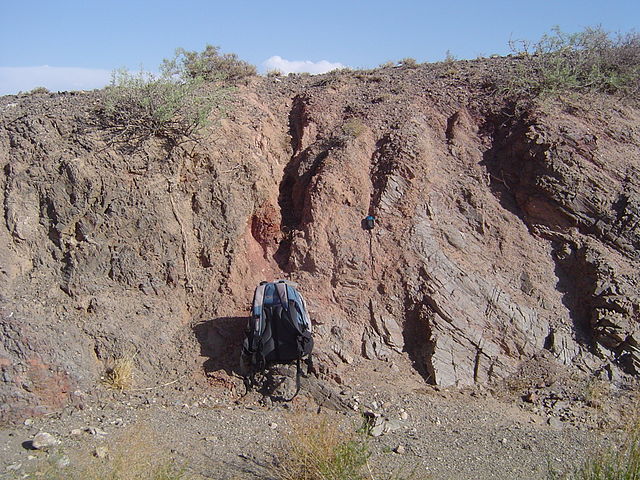
File:FaultGouge.JPG

Size of this preview: 640 × 480 pixels.
| |
This is a file from the Wikimedia Commons. Information from its description page there is shown below.
Commons is a freely licensed media file repository. You can help. |
Summary
| Description |
English: A small fault cuts between the lighter grey rocks on the right and the darker grey rocks on the left. Fault gouge is seen as the salmon-colored rock in the centre of the picture above the backpack. from Tavan Har, the Gobi, Mongolia.
|
| Date | 04:02, 12 June 2010 (UTC) (Uploaded on Commons at 2011-03-27 17:41:55 (UTC)/Original uploaded at 2010-06-12 04:02:12) |
| Source | I ( Qfl247 ( talk)) created this work entirely by myself. (Original uploaded on en.wikipedia) |
| Author | Qfl247 ( talk) (Transferred by Citypeek/Original uploaded by Qfl247) |
Licensing
|
File usage
The following pages on Schools Wikipedia link to this image (list may be incomplete):
Metadata
This file contains additional information, probably added from the digital camera or scanner used to create or digitize it. If the file has been modified from its original state, some details may not fully reflect the modified file.
| Camera manufacturer | SONY |
|---|---|
| Camera model | DSC-P72 |
| Exposure time | 1/640 sec (0.0015625) |
| F-number | f/5.6 |
| ISO speed rating | 100 |
| Date and time of data generation | 09:51, 3 July 2004 |
| Lens focal length | 6 mm |
| Orientation | Normal |
| Horizontal resolution | 72 dpi |
| Vertical resolution | 72 dpi |
| Software used | QuickTime 6.5.1 |
| File change date and time | 13:12, 18 July 2004 |
| Y and C positioning | Co-sited |
| Exposure Program | Normal program |
| Exif version | 2.2 |
| Date and time of digitizing | 09:51, 3 July 2004 |
| Image compression mode | 4 |
| Exposure bias | 0 |
| Maximum land aperture | 3 APEX (f/2.83) |
| Metering mode | Pattern |
| Light source | Unknown |
| Flash | Flash did not fire |
| Colour space | Uncalibrated |
| Custom image processing | Normal process |
| Exposure mode | Auto exposure |
| White balance | Auto white balance |
| Scene capture type | Standard |
I want to learn more...
SOS Children aims to make Wikipedia suitable for young learners. SOS Childrens Villages works in 133 countries and territories across the globe, helps more than 62,000 children, and reaches over 2 million people in total. Will you help another child today?

